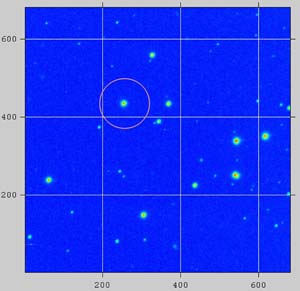Nearly-Naked Stars Boost the Pulse of Asteroseismology

Figure1: A 5x5 arcminute CCD image of the prototype gravity-mode pulsating subdwarf B star, PG1716+426, and nearby comparison stars. North is up and East is to the left. The subdwarf B star pulsator is the brightest star in the northeast quadrant. The image was taken through an R filter at the University of Arizona Mt. Bigelow 1.6 m telescope and is one of hundreds used to measure the light curve of the star. <br>Photo Credit: Courtesy of Elizabeth Green of Steward Observatory at the University of Arizona and NSF. <br>
What goes on inside the heart of a star? Astronomers have been developing theories about stars’ inner workings for decades, but evidence to confirm the details of those theories has been sparse.
In research supported by NSF, University of Arizona astronomer Elizabeth Green and colleagues have found a new subset of “nearly-naked” stars that dim and brighten due to pulses in their cores. The stars, which may help unlock secrets of advanced stages of stellar evolution, are described in the January 20 Astrophysical Journal Letters.
Chemical and physical changes inside star cores cause the light they emit to pulsate, becoming brighter and dimmer in slowly changing patterns. Analysis of these pulsations would give scientists a better of idea of the processes going on inside stars and help them understand how they change from one type to another. Until now, though, astronomers have been frustrated by the faintness of the pulses.
One problem is that most star cores are wrapped in a thick envelope of hydrogen gas that obscures any pulses that might occur. In 1997, astronomers thought they had found a new approach to the problem when they discovered a new class of pulsating stars, called subdwarf B stars. These stars are very hot evolved stars that have lost that outer envelope and are essentially “naked” cores. However, previous observations of the hottest subdwarf B stars revealed that their pulsations are weak and generally occur only minutes apart, making them hard to measure with conventional telescopes.
Astronomer Elizabeth Green, working with undergraduates from the University of Arizona, has been observing 80 cooler subdwarf B stars and is now releasing eye-opening results. Using a telescope operated by the university’s Steward Observatory, the group found that 20 of the cooler stars commonly pulsate at relatively long intervals of about one hour, and that each star also has several pulse patterns. Green’s collaborators, researchers Gilles Fontaine of the University of Montreal, and Mike Reed of Southwest Missouri State, say the processes causing the pulses are not yet understood, but that they originate in much deeper layers of the star than pulses in the hotter subdwarf B observed before.
Because they are abundant and easier to observe, the newly discovered stars should expand opportunities for researchers around the world to carry out asteroseismology. Using the multiple pulses, researchers will study the hearts of stars much as seismologists on earth study earthquakes to determine the Earth’s interior structure.
Most of what scientists know about stellar interiors is based on theory, but there are competing explanations of why stars like our sun evolve from one type to another. Now that models of star cores will have to explain not just one but several patterns of pulsation in a single star, Green says the new data will narrow the field of theories and help researchers better predict the eventual fate of stars like our own Sun
Media Contact
All latest news from the category: Physics and Astronomy
This area deals with the fundamental laws and building blocks of nature and how they interact, the properties and the behavior of matter, and research into space and time and their structures.
innovations-report provides in-depth reports and articles on subjects such as astrophysics, laser technologies, nuclear, quantum, particle and solid-state physics, nanotechnologies, planetary research and findings (Mars, Venus) and developments related to the Hubble Telescope.
Newest articles

High-energy-density aqueous battery based on halogen multi-electron transfer
Traditional non-aqueous lithium-ion batteries have a high energy density, but their safety is compromised due to the flammable organic electrolytes they utilize. Aqueous batteries use water as the solvent for…

First-ever combined heart pump and pig kidney transplant
…gives new hope to patient with terminal illness. Surgeons at NYU Langone Health performed the first-ever combined mechanical heart pump and gene-edited pig kidney transplant surgery in a 54-year-old woman…

Biophysics: Testing how well biomarkers work
LMU researchers have developed a method to determine how reliably target proteins can be labeled using super-resolution fluorescence microscopy. Modern microscopy techniques make it possible to examine the inner workings…





















